Team-based challenges in multiplayer fantasy adventure games enhance collaboration and strategic gameplay. These challenges require effective communication, role specialization, and coordination among players. Key issues include synchronization problems, communication breakdowns, and strategy misalignment. Emerging trends for 2025 focus on enhanced cooperative gameplay and dynamic quest systems, promoting deeper player engagement and teamwork.
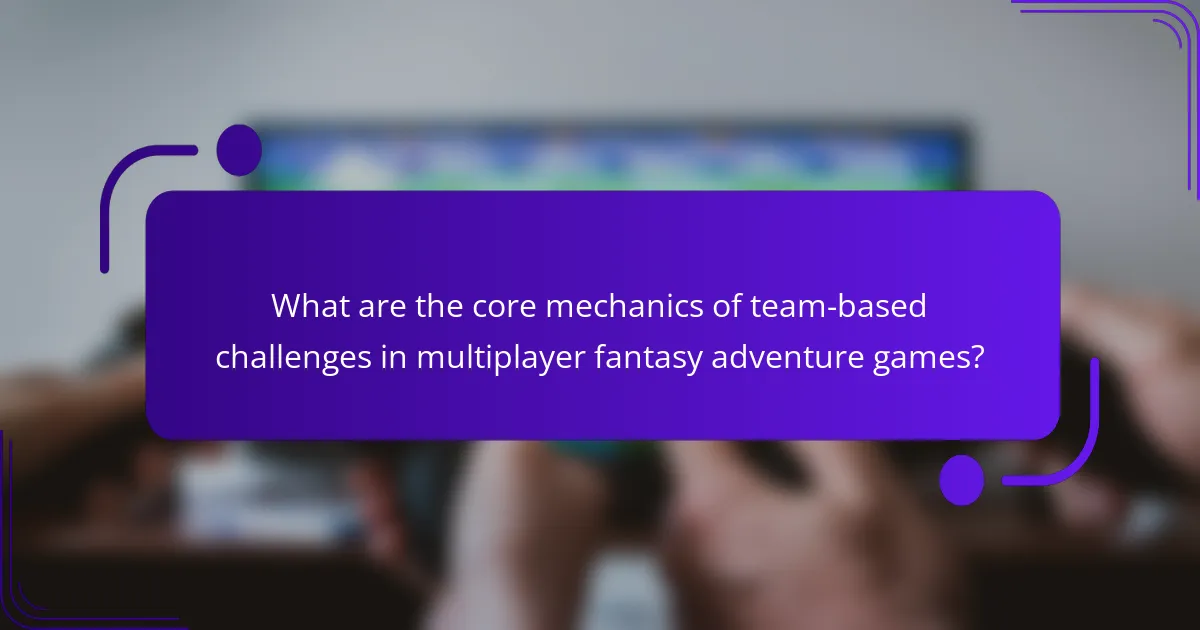
What are the core mechanics of team-based challenges in multiplayer fantasy adventure games?
Team-based challenges in multiplayer fantasy adventure games require collaboration, strategy, and communication among players. These challenges often involve completing quests, defeating bosses, or solving puzzles that necessitate diverse skills and roles within a team.
Key mechanics include role specialization, where players adopt specific functions, such as damage dealers or healers, enhancing team efficiency. Coordination is crucial; players must synchronize their actions to overcome obstacles effectively.
Additionally, the challenges often feature dynamic environments that change based on player actions, requiring adaptability. Teams may face time constraints or resource management issues, adding layers of complexity to the gameplay.
Ultimately, successful navigation of these challenges fosters teamwork and enhances the overall gaming experience.
How do cooperative gameplay elements enhance team dynamics?
Cooperative gameplay elements significantly enhance team dynamics by fostering communication, trust, and strategic collaboration. Players must coordinate their actions and share resources, leading to stronger interpersonal bonds. This interaction promotes a sense of belonging and shared achievement, which is vital in team-based challenges. For example, in multiplayer fantasy adventure games, players often rely on each other’s unique abilities to overcome obstacles, enhancing the overall gaming experience. As a result, these elements create a more immersive and rewarding environment for all participants.
What role does communication play in successful team strategies?
Effective communication is crucial for successful team strategies in multiplayer fantasy adventure games. It fosters collaboration, enhances problem-solving, and builds trust among team members. Clear communication ensures that players understand their roles, strategies, and objectives, leading to coordinated efforts during gameplay.
Moreover, active listening allows teams to adapt and respond to challenges dynamically. This adaptability is essential in fast-paced environments where in-game situations can change rapidly. Regular feedback and open dialogue encourage continuous improvement, enabling teams to refine their strategies and enhance performance.
In summary, strong communication serves as the foundation for teamwork, ultimately driving success in multiplayer fantasy adventure games.
Which game design features promote teamwork and collaboration?
Team-based challenges in multiplayer fantasy adventure games promote teamwork and collaboration through shared objectives, resource management, and strategic communication. These features encourage players to work together effectively.
Shared objectives require players to unite their efforts to achieve common goals, fostering a sense of camaraderie. Resource management necessitates collaboration, as players must allocate items and skills efficiently. Strategic communication enhances coordination, allowing teams to devise tactics and respond to challenges dynamically.
Additionally, character classes with unique abilities create interdependence, where players rely on each other’s strengths to overcome obstacles. As a result, players develop trust and strengthen their bonds, enhancing the overall gaming experience.
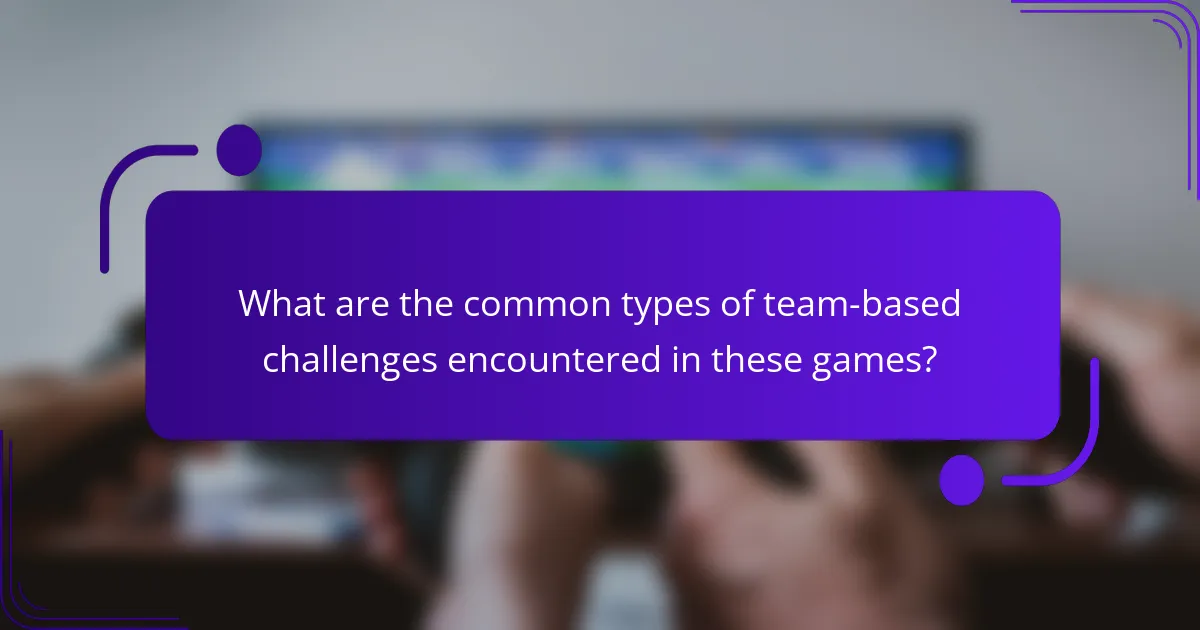
What are the common types of team-based challenges encountered in these games?
Team-based challenges in multiplayer fantasy adventure games often include coordination issues, communication breakdowns, role assignment conflicts, and strategy misalignment. These challenges can hinder team performance and success.
Coordination issues arise when players struggle to synchronize their actions, leading to missed opportunities. Communication breakdowns occur when team members fail to share vital information, affecting decision-making. Role assignment conflicts happen when players have differing expectations about their responsibilities, causing confusion. Strategy misalignment results from a lack of consensus on the team’s goals or tactics, which can derail progress in the game.
Addressing these challenges requires effective teamwork, clear communication, and a shared understanding of roles and strategies.
How do combat challenges differ from puzzle-solving challenges?
Combat challenges focus on teamwork and strategy to defeat enemies, while puzzle-solving challenges emphasize collaboration to solve problems. Combat challenges require real-time coordination and skill execution, often involving unique attributes like character abilities and enemy types. In contrast, puzzle-solving challenges may involve rare attributes such as environmental interactions and logic-based tasks. Both types enhance team dynamics in multiplayer fantasy adventure games, but they engage players in different ways, fostering diverse skills and experiences.
What unique scenarios require strategic planning and coordination?
Unique scenarios in multiplayer fantasy adventure games require strategic planning and coordination when players face complex quests, boss battles, or resource management challenges. These situations demand teamwork to achieve objectives effectively.
In cooperative gameplay, players must align their roles and abilities. For instance, a balanced team composition enhances success rates in difficult encounters. Moreover, communication is vital for coordinating attacks and defenses during high-stakes moments.
Time-sensitive missions also necessitate precise planning. Players must strategize their actions to complete objectives within set limits, ensuring efficiency and effectiveness.
Lastly, navigating unpredictable environments, such as dynamic dungeons or shifting landscapes, requires adaptability and foresight. Teams must adjust their strategies to tackle unforeseen challenges while maintaining cohesion.
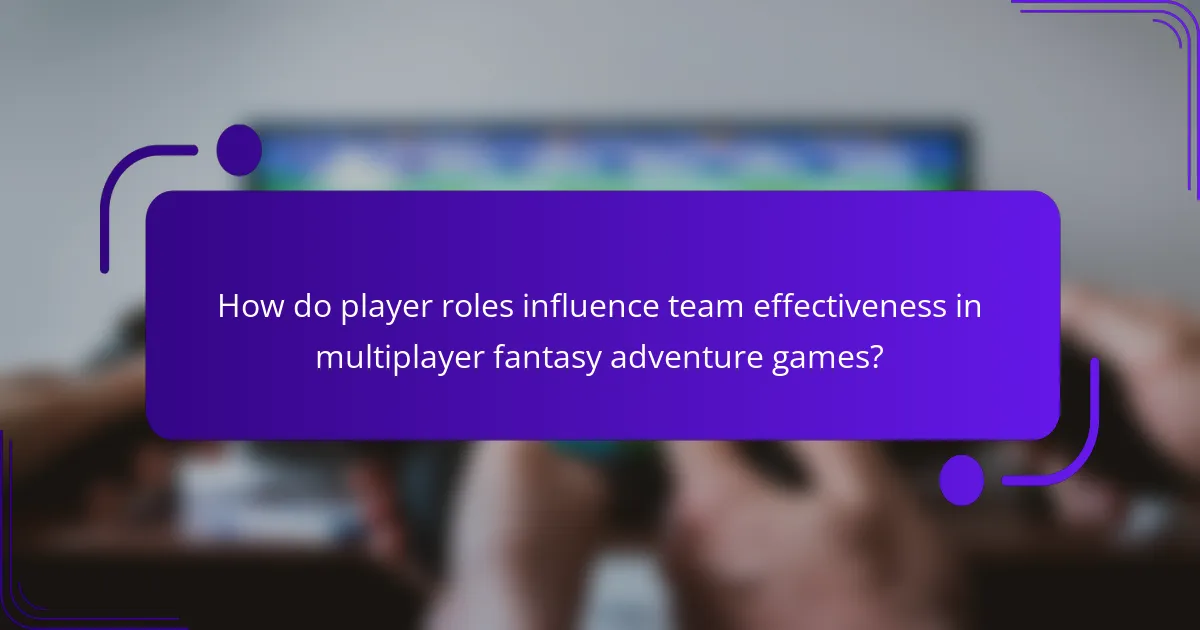
How do player roles influence team effectiveness in multiplayer fantasy adventure games?
Player roles significantly enhance team effectiveness in multiplayer fantasy adventure games by promoting synergy and strategic collaboration. Each role, such as tank, healer, or damage dealer, contributes unique abilities that complement others, optimizing overall performance. Effective communication and understanding of roles lead to better coordination during challenges, resulting in successful outcomes. Additionally, players can adapt their strategies based on the strengths and weaknesses of their teammates, fostering a dynamic and responsive gameplay experience.
Which character classes are most commonly involved in team-based challenges?
The most commonly involved character classes in team-based challenges are tanks, healers, and damage dealers. Tanks absorb damage and protect teammates. Healers restore health and support the team. Damage dealers focus on eliminating enemies quickly. Each class plays a unique role in ensuring team success during challenges.
How do individual player skills contribute to overall team success?
Individual player skills significantly enhance overall team success in multiplayer fantasy adventure games. Each player’s unique abilities contribute to diverse strategies and collaborative gameplay.
For example, a player with strong healing skills can support teammates during battles, while a player with high damage output can eliminate threats quickly. This synergy allows teams to tackle challenges more effectively.
Moreover, communication and coordination among players amplify the impact of individual skills. Teams that strategize based on each member’s strengths can adapt to varying scenarios, leading to higher success rates in quests and battles.
In summary, the combination of individual skills, teamwork, and strategic planning drives the success of teams in these games.
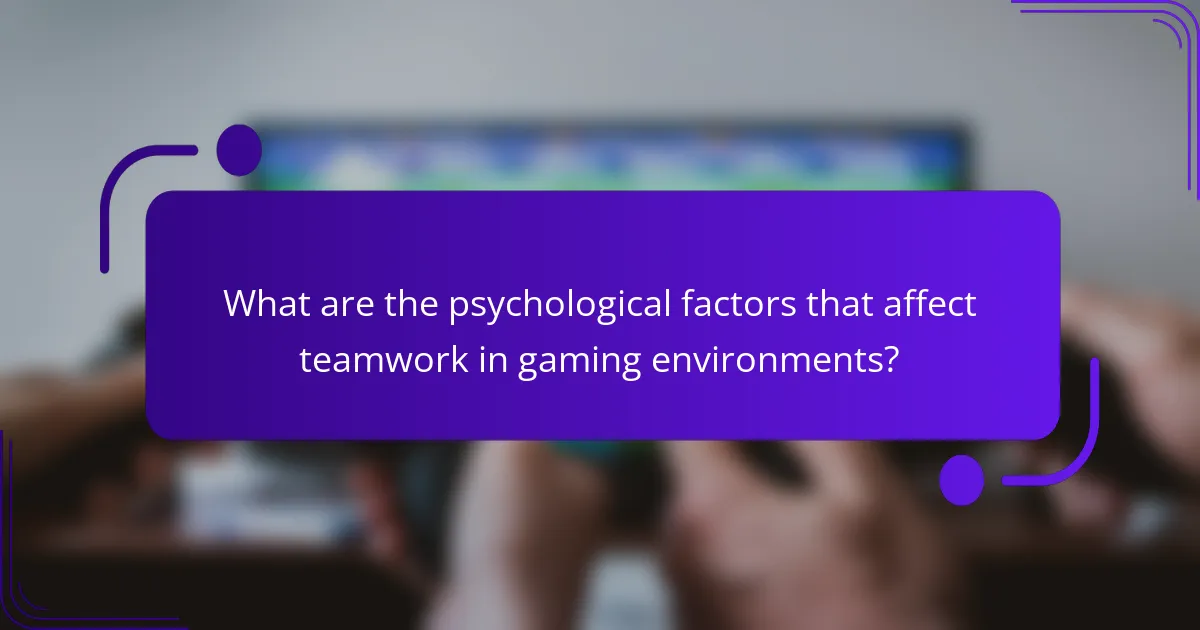
What are the psychological factors that affect teamwork in gaming environments?
Psychological factors significantly impact teamwork in multiplayer fantasy adventure games. Effective communication fosters collaboration, while trust enhances team dynamics. Motivation drives player engagement, and conflict resolution skills are crucial for overcoming challenges. Additionally, shared goals align team efforts, promoting unity and success in gameplay.
How does player motivation impact team performance?
Player motivation significantly influences team performance in multiplayer fantasy adventure games. High motivation fosters collaboration, enhances communication, and boosts overall engagement. When players are driven to succeed, they contribute more effectively to team strategies and objectives. This can lead to improved outcomes, such as higher win rates and better resource management. Motivated players are also more likely to support each other, creating a positive team dynamic. Conversely, low motivation can result in disengagement, poor teamwork, and diminished performance. Understanding these dynamics is crucial for game developers and team leaders aiming to optimize player experiences.
What are the common interpersonal challenges faced by teams?
Teams in multiplayer fantasy adventure games often face communication breakdowns, conflicting goals, and role ambiguity. These challenges can lead to frustration and decreased performance. Effective strategies include establishing clear roles, encouraging open dialogue, and setting shared objectives. Addressing these issues enhances team cohesion and improves gameplay experience.
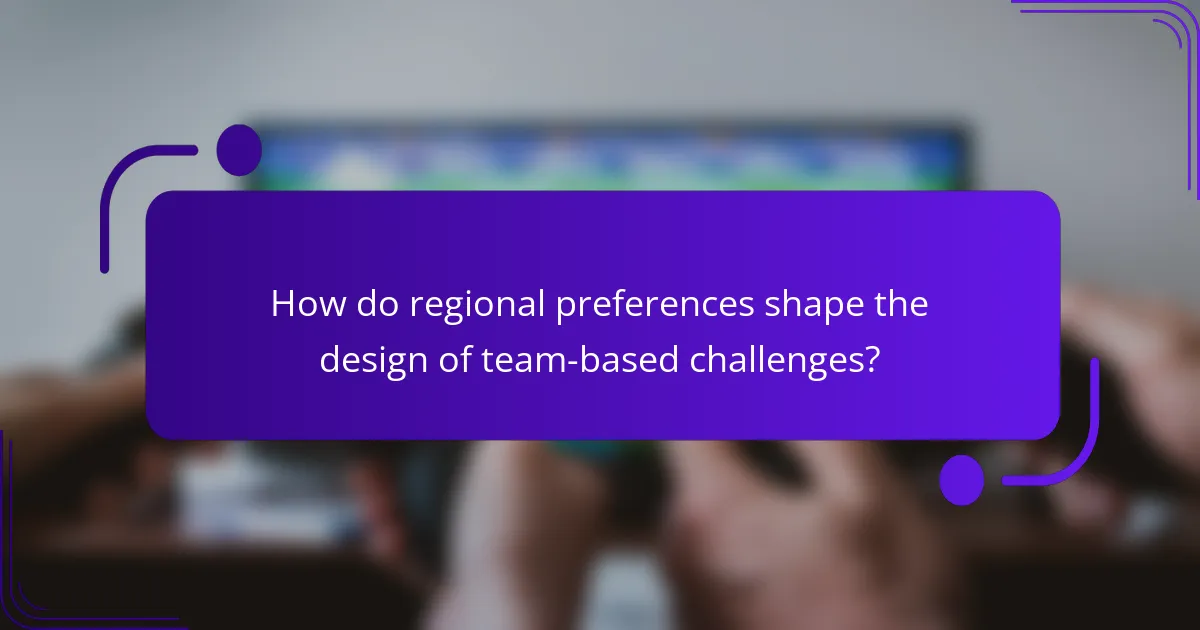
How do regional preferences shape the design of team-based challenges?
Regional preferences significantly influence the design of team-based challenges in multiplayer fantasy adventure games. Developers often tailor challenges to align with cultural values, play styles, and social dynamics prevalent in specific regions. For instance, some cultures may prefer cooperative gameplay, while others may favor competitive elements.
Additionally, regional preferences can dictate the themes and narratives within challenges. In regions with a rich history of folklore, challenges may incorporate local myths, enhancing player engagement. As a result, developers must conduct thorough market research to understand these preferences, ensuring that challenges resonate with their target audience.
Moreover, the mechanics of challenges can vary based on regional gaming habits. In some areas, players might enjoy time-limited events, while others may prefer more leisurely, exploration-focused challenges. This diversity necessitates a flexible design approach that accommodates various play styles and preferences.
Ultimately, acknowledging and integrating regional preferences leads to more immersive and enjoyable experiences, fostering a stronger connection between players and the game.
Which cultural trends influence gameplay styles in different regions?
Cultural trends significantly shape gameplay styles in team-based multiplayer fantasy adventure games. Regional preferences influence strategies, communication methods, and collaboration approaches among players.
In North America, competitive gameplay often emphasizes individual skill and rapid decision-making. Players tend to favor aggressive strategies that prioritize quick victories. In contrast, European players generally focus on teamwork and strategic planning, valuing coordinated efforts over individual prowess.
Asian gaming cultures often incorporate social elements, with players forming tight-knit communities. This leads to gameplay styles that emphasize collaboration and social interaction. For example, in Japan, players may engage in cooperative storytelling, enhancing the overall gaming experience.
These cultural differences create diverse gameplay dynamics, enriching the multiplayer fantasy adventure landscape. Understanding these trends allows developers to tailor experiences that resonate with regional audiences.
How do local gaming communities impact team collaboration?
Local gaming communities significantly enhance team collaboration in multiplayer fantasy adventure games by fostering communication and trust among players. These communities provide a platform for players to share strategies, discuss challenges, and build relationships, which are crucial for effective teamwork.
Collaborative gameplay often leads to improved problem-solving skills as players work together to overcome obstacles. Engaging with a local community can also motivate players to participate more actively, leading to higher levels of commitment and performance.
Additionally, the social aspect of local gaming communities encourages players to learn from one another, sharing unique insights and tactics that can enhance overall team dynamics. As a result, players can adapt more quickly to team-based challenges, improving their collective success in the game.
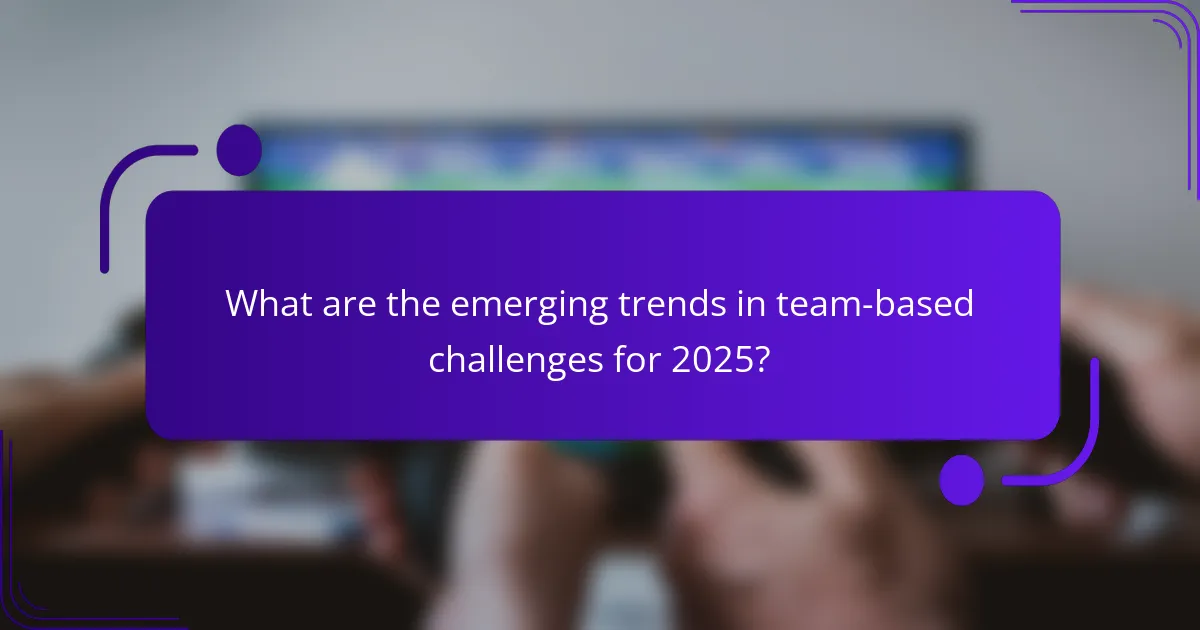
What are the emerging trends in team-based challenges for 2025?
Emerging trends in team-based challenges for 2025 include enhanced cooperative gameplay, dynamic quest systems, and AI-driven NPC interactions. These innovations foster deeper collaboration and strategic planning among players.
Enhanced cooperative gameplay emphasizes teamwork through shared objectives and unique character roles. Dynamic quest systems adapt to player choices, creating personalized experiences that require group coordination. AI-driven NPC interactions provide real-time challenges, enhancing immersion and requiring teams to strategize effectively.
These trends reflect a shift towards more engaging and interactive multiplayer experiences, encouraging players to work together in innovative ways.
How are technological advancements changing the landscape of multiplayer games?
Technological advancements are transforming multiplayer games by enhancing team-based challenges through improved graphics, AI, and connectivity. These innovations create more immersive environments, allowing players to collaborate in real-time. Enhanced AI systems enable dynamic NPC interactions, making challenges more engaging. Additionally, cloud gaming technology facilitates seamless access, enabling players to join teams from various devices. The integration of virtual and augmented reality also enriches gameplay, providing unique experiences that deepen player involvement and strategy development.
What innovative gameplay mechanics are being introduced?
Innovative gameplay mechanics in team-based challenges include cooperative puzzle-solving, dynamic role specialization, and real-time strategy adjustments. These elements enhance player interaction and strategy, fostering deeper collaboration. Unique mechanics like environmental manipulation and asynchronous team tasks create varied gameplay experiences, keeping players engaged. Additionally, rare features such as cross-platform team challenges encourage broader community participation.
What are the best practices for fostering teamwork in multiplayer fantasy adventure games?
Effective teamwork in multiplayer fantasy adventure games hinges on clear communication, defined roles, and shared goals. Establishing open dialogue encourages collaboration and problem-solving. Assigning specific roles leverages individual strengths, enhancing overall performance. Setting common objectives fosters unity and motivates players to work together. Regular feedback and adaptation improve strategies and strengthen bonds among team members.